Few parks capture the public imagination—or represent the quintessential American West—as much as Grand Teton National Park. Home to soaring pinnacles, abundant wildlife and superlative outdoor activities, the Tetons welcome millions of visitors each year from across the globe.
Ask any visitor what their favorite part of Grand Teton National Park is, and chances are they’ll all say something different. Steep, skyscraping peaks satisfy those looking for a dose of high-octane recreation, while the tranquility of the park’s meadows and glacial lakes makes for an equally peaceful escape. The nearby town of Jackson has an authentic, Old West appeal, allowing plenty of amenities without losing the rugged charm of the region.
Thinking about taking a trip to the Tetons? This destination guide has tons of relevant info and tips, including:
- Why Visit Grand Teton National Park?
- Top Activities in Grand Teton National Park
- How to Plan Your Trip to Grand Teton National Park
Why Visit Grand Teton National Park?
Even before you set foot in the park, it’s easy to understand why total visits nearly topped five million in 2017. The drive into the park along Highway 191 is an experience all its own, crossing the wide-open expanse of Jackson Hole while the Snake River flows lazily down valley. Here, U-shaped glacial canyons cut through the heart of the range, craggy peaks carve their way into the Wyoming sky, and alpine meadows burst with colorful wildflowers in the spring.

A guided rafting tour on the Dead Man’s to Moose section of the Snake River takes in epic views of the Tetons.
Grand Teton National Park teems with wildlife, including elk, bison, moose, wolves, grizzly and black bears, and hundreds of other species. And although the shift from summer to winter in the Tetons is stark, the park welcomes visitors all year long with a rotating cast of outdoor activities on tap depending on the season.
Highlights of Grand Teton National Park
Hiking Cascade Canyon: The trail into Cascade Canyon is the perfect way to warm up your legs if you plan to spend a few days exploring the Tetons. Viewpoints at Hidden Falls and Inspiration Point along the way turn this hike into a family-friendly option. Hikers can choose to take the ferry across Jenny Lake or hike two miles around the lake from South Jenny Lake Trailhead. The 9-mile out-and-back hike winds through conifer forests and huckleberry patches, before continuing along a mellow trail through the jagged, walled canyon.
Hiking Death Canyon: Tucked into the park’s southern reaches, Death Canyon is an off-the-radar gem that includes tumbling waterfalls, dramatic geology and even a natural spring, if you know where to look. Take the Moose-Wilson road from Teton Village or the park interior to access.
Hiking Static Peak Divide: The Static Peak Divide Trail is a long, rewarding day hike with some of the most striking views that Grand Teton National Park has to offer. The 16-mile round-trip trail rises to 10,790 feet above sea level, making it the highest hikeable mountain pass within park boundaries. Unsurprisingly, Static Peak got its name for how frequently it gets struck by lightning; in summer, plan to start early and turn around by noon, before the afternoon storms roll in.

A hiker enjoys the solitude of Delta Lake. (Photo credit: Sam Morse)
Hiking to Amphitheater/Delta Lake: Beginning at the Lupine Meadows Trailhead, the hike to Amphitheater Lake offers up what is perhaps the best spot in Grand Teton National Park to enjoy an afternoon picnic in the high alpine. After a 5-mile hike in, you’ll be flanked by some of the park’s most notable giants—the Middle Teton, Disappointment Peak, the Grand, Mount Owen and Teewinot Mountain—while you dip your toes in the cold, glacial water. Bear sightings are common along this trail, so be sure to carry bear spray with you at all times and know how to use it.
Climbing the Grand Teton: As the park’s namesake, “the Grand” gets plenty of attention from locals and visitors alike—and for good reason. At 13,775 feet, the Grand is a mix of harrowing exposure—yet relatively approachable route difficulty—that draws alpinists from all over the world. Exum Mountain Guides offers a multiday climb for those without prior climbing experience, including two days of instruction before a guided overnight trip to the summit.
Brenton Reagan, one of Exum’s lead guides, says that for many, climbing the Grand feels like a classic American adventure and something people dream about their whole lives. “Traveling out to the Wild West, climbing a mountain in a traditional style, it’s just so pure,” he says.
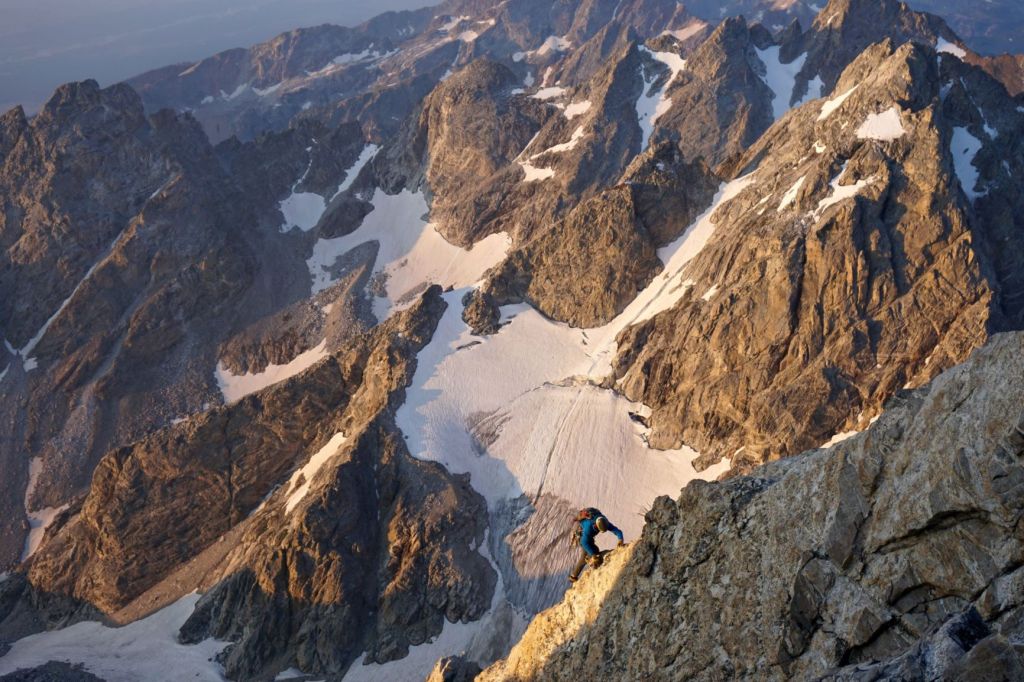
Exum guide Brian Campbell ascends the Friction Ridge pitch of the Grand Teton’s Exum Ridge. (Photo credit: Exum Mountain Guides)
Viewpoints: The abundance of scenic viewpoints in Grand Teton National Park makes it easy to enjoy striking views of the park regardless of your mode of travel. Because the Tetons run along a north-south axis, sunrises and sunsets are almost always dramatic, with the jagged range illuminated from either side. At sunrise, enjoy the bright pink alpenglow from Schwabacher Landing or the Snake River Overlook, two viewpoints just off Highway 191. A quarter-mile walk from the Schwabacher Landing parking lot will lead you to a riverside spot where the glassy reflection of the mountains shines up from the still waters of the Snake River.
The Snake River Overlook is perhaps the most recognizable viewpoint in the park, with a broad view of the Snake River winding toward the mountains. This spot may look familiar—it’s where Ansel Adams shot his iconic black-and-white photo of the Tetons in 1942.
The Jenny Lake Overlook along the Jenny Lake Scenic Drive offers a glimpse into the narrow walls of Cascade Canyon from across the lake. If you’re tempted to get a closer look, Jenny Lake Boating offers a shuttle service across the lake to the Hidden Falls and Cascade Canyon Trailheads.
Moose-Wilson Road: A rugged, eight-mile stretch that runs between the south end of the park and Teton Village, the Moose-Wilson Road (named for two communities) provides good opportunities for spotting wildlife from your car. The narrow, partially-paved road gets backed up midday in the summer, but it’s not uncommon to spot black bears and moose grazing in the underbrush just a few feet from your window. Be sure to check the road status before you head out, as closures happen frequently due to grizzly bear activity.
Teton Crest Trail: If you want to challenge yourself, the Teton Crest Trail is an iconic 40-mile backpacking traverse that runs south to north through the park. High alpine meadows, rugged peaks and glacial lakes accompany hikers through the heart of this technical hike. This trek typically starts from either the top of the tram at Jackson Hole Mountain Resort or the Granite Canyon Trailhead, taking three or four days to descend via Paintbrush Canyon. Be prepared for high altitudes before you commit: the Teton Crest Trail is almost entirely above 8,000 feet.
Nearby
Teton Pass: In the winter, Teton Pass is a bustling hub of backcountry skiers and riders hustling to get a few turns in before work. The bootpack up Mount Glory is an icy, unforgiving 1,800-foot staircase that leads to steep lines on all aspects. Come summertime, the mountain biking is world-class, with steep flow trails and jump lines that are sure to get your blood pumping.
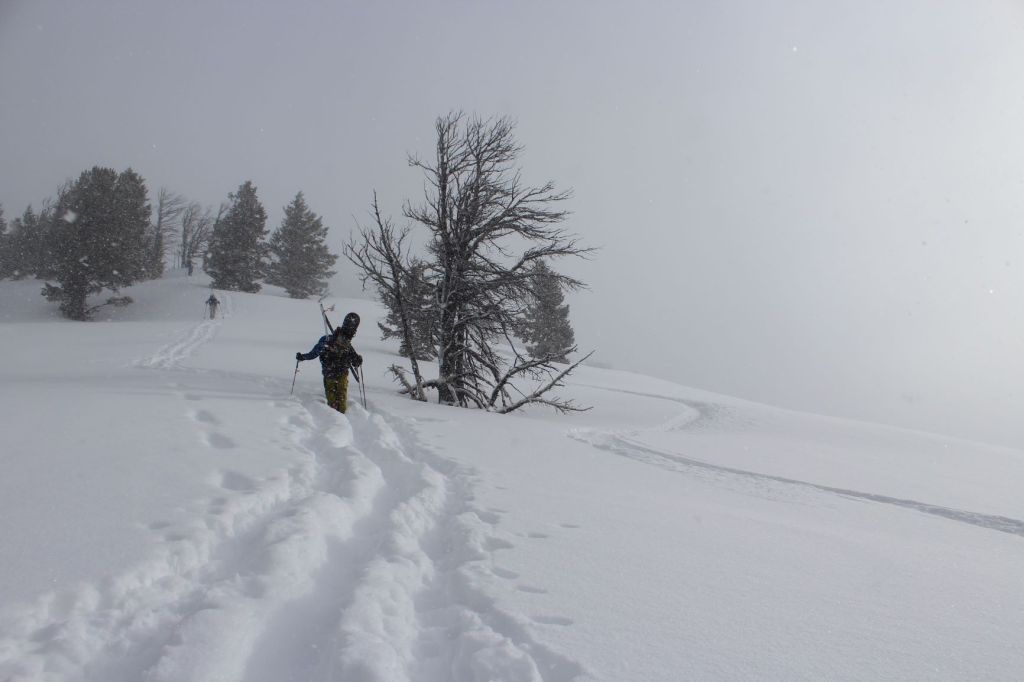
Backcountry skiers and snowboarders trudge up Teton Pass’ 1,800-foot Mount Glory bootpack. (Photo credit: Sam Morse)
Hiking Sheep Mountain: Sheep Mountain is known by locals as the “Sleeping Indian” because of its likeness to a headdress-wearing man crossing his arms. This 5-mile ridge is easy to recognize from the town of Jackson and rises to 11,239 feet in the nearby Gros Ventre Range. The 14-mile round-trip hike is steep, rugged and doesn’t see many hikers, but it opens up new views of the Wind River Range to the east and spectacular views of the Tetons to the west.
Top Things to Do in Grand Teton National Park
The myriad of recreation options available in the park let you explore the beauty of the Tetons by foot, bike, raft or kayak. Each activity is reason enough on its own to pay a visit to the park, and the wide variety lets you see a different side of the Tetons as the seasons change.
Activities in Grand Teton National Park
Hiking: With over 200 miles of hiking trails in Grand Teton National Park, there’s undoubtedly an option for everyone. Short hikes up to Hidden Falls or the Phelps Lake Overlook are great activities for kids or those less comfortable with high altitude, while multiday treks into Alaska Basin or along the Teton Crest Trail put seasoned backpackers to the test. The park is home to both grizzly and black bears, so the National Park Service advises hiking in groups of three or more, making plenty of noise and always carrying bear spray.
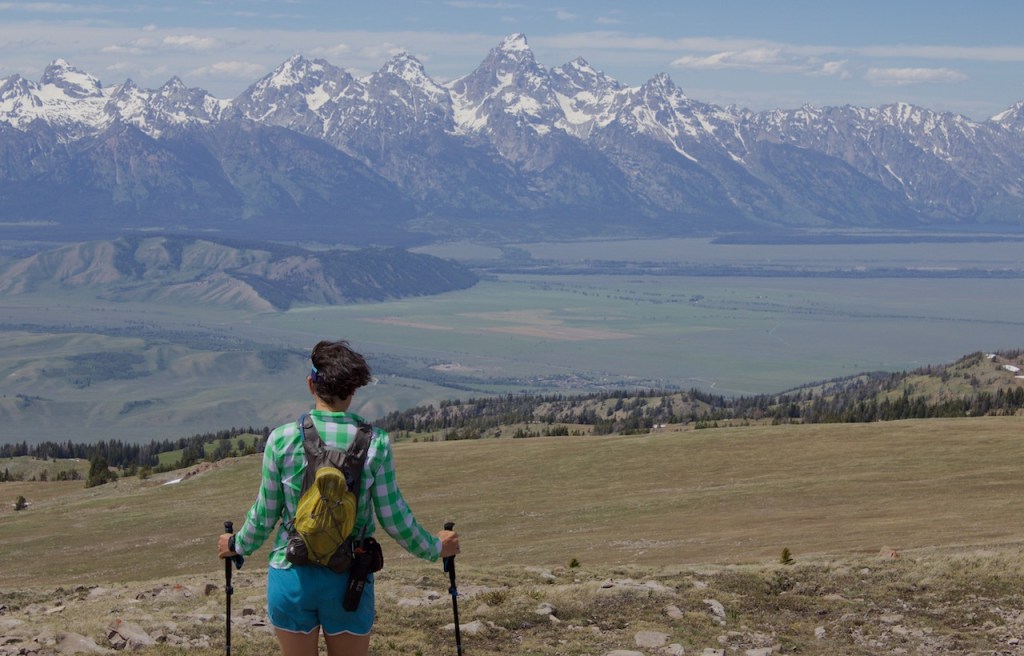
A hiker takes in the Tetons—and entirety of Jackson Hole—from the top of Sheep Mountain. (Photo credit: Sam Morse)
Climbing: With technical multi-pitch routes and steep, exposed scrambles, the climbing in Grand Teton National Park draws sport climbers and alpinists from all over the world. No prior experience? No problem. Exum Mountain Guides is the oldest guiding service in North America, operating out of Grand Teton National Park for over 80 years, and many of their customers have never roped up before. “Most clients who come to us have little to no climbing experience,” says Exum guide Brenton Reagan. “If they come with a solid level of fitness, we can pretty quickly teach them the rest.”
For those with prior experience, Reagan says that hiring a guide is still a worthwhile endeavor, especially during a short visit to the park. “It just cuts down on so many logistics,” he says. “Even if you’re an experienced climber, chances are you’re already doing so much to get ready for your trip, it’s not easy to dial in all your route-finding and weather beta while you’re trying to get out the door.”
Boating: In the summer and fall, Grand Teton National Park’s glacially-carved lakes are best enjoyed by boat. At 40 square miles and containing more than 15 islands, Jackson Lake offers lots of options for recreation, allowing motorized boats, sailboats, canoes and kayaks. Permits to camp on Grassy Island or Elk Island are scarce, but if you can snag one you’ll enjoy a secluded night under the stars, with stunning views of the Tetons.
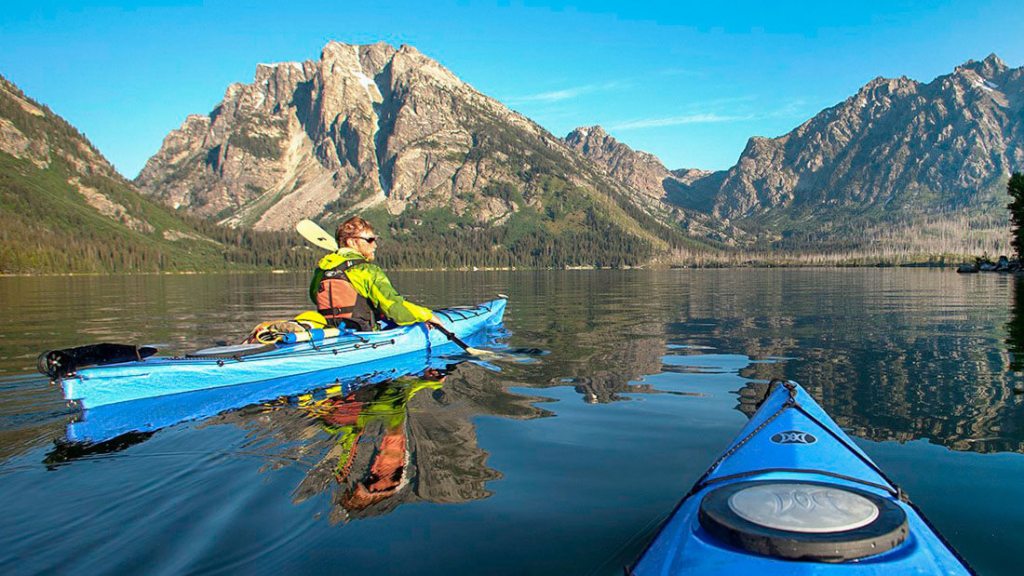
A group of kayakers take in the majesty of Mount Moran from the placid waters of Leigh Lake.
To get a little farther off the beaten path, paddle around Leigh Lake and spend the night at one of the eight campsites along the water. Leigh Lake can be accessed through a short portage on the north side of String Lake and has more of a remote, backcountry feel since it’s not accessible by vehicle. Campsites on the western shore of Leigh Lake are paddle-in only and boast some of the best views of Mount Moran. Check out Jenny Lake Boating and Jackson Lake Boat Rentals at Signal Mountain Lodge for daily or hourly rentals.
Road Cycling and Mountain Biking: Multi-use pathways run all the way from the town of Jackson up to the South Jenny Lake turnout, with a designated bike path after the junction. Spring is the perfect time to enjoy a two-wheeled ride along the Inner Park Loop—a 14-mile stretch of road from the Taggart Lake Trailhead to Signal Mountain Lodge—since the road is plowed in April but not open to cars until May 1. The scenic route passes by plenty of Teton classics, including Jenny Lake, String Lake and the Cathedral Group turnout.
Mountain biking is not allowed within park boundaries but thrill seekers can get their fix on nearby downhill trails like Black Canyon, a fast and steep six-mile trail that descends over 2,700 feet from the top of Teton Pass into the town of Wilson. The Game Creek Loop in Jackson is a more traditional cross-country option, including endurance-testing switchbacks, ridgeline traverses and fast-and-flowy descents.
Skiing and Snowboarding: Some of the world’s most well-known extreme skiers and riders have come out of the Tetons, and every year experts make the pilgrimage to Teton Village to see how they fare. However, if you want get away from the crowds and you’re willing to work for your turns, the park has some of the best and most accessible backcountry terrain in the country. Mellow gladed runs, technical ski-mountaineering descents and everything in between—you could spend decades skiing in the park and never run out of terrain.
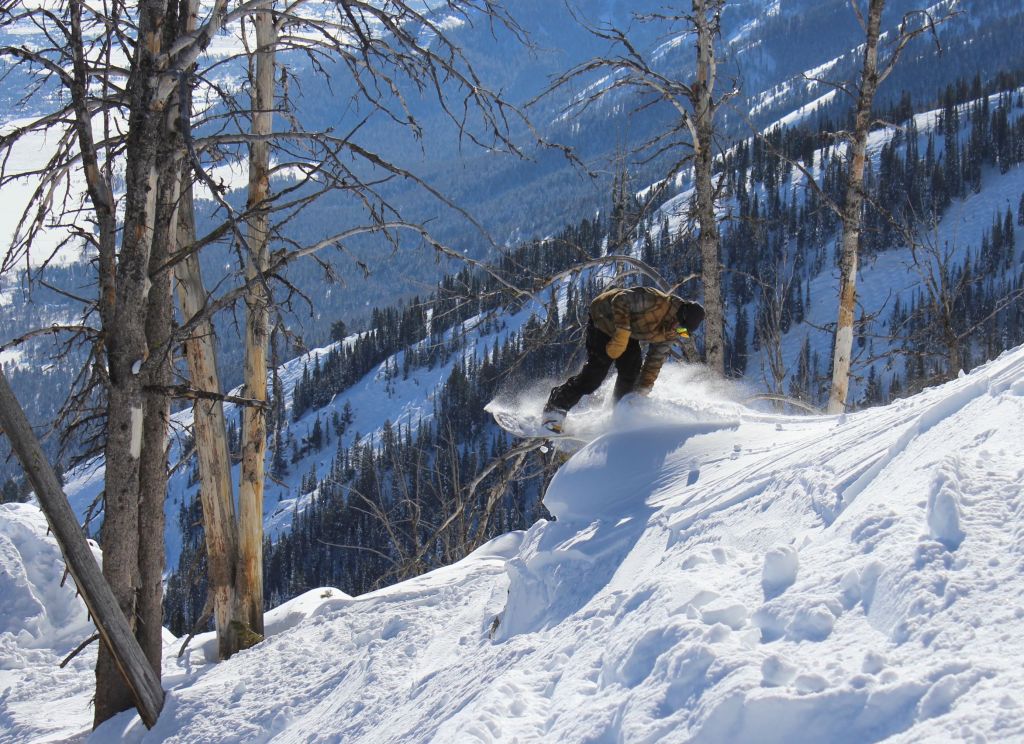
A snowboarder enjoys fresh powder at Jackson Hole Mountain Resort. (Photo credit: Sam Morse)
Photography: Scenic viewpoints in and out of the park make it easy to capture the beauty of the Tetons through a lens. Catch the golden fall foliage in front of a mountainous backdrop at the Oxbow Bend viewpoint along Highway 191 or head over to the town of Kelly for a zoomed out view of the jagged peaks with bison and elk wandering in the foreground.
Note about wildlife: It’s important to appreciate the wildlife in Grand Teton National Park from a distance. The park service requires visitors to stay at least 100 yards from bears and wolves and 25 yards from all other wildlife, and it’s imperative to avoid getting between mother and offspring. It is illegal to feed wildlife as this can cause them to become dependent on humans for food.
How to Plan Your Trip to Grand Teton National Park
Where to stay
Car Camping: There are five designated front-country camping areas inside the park boundaries, open during the spring, summer and fall. Camping spots are on a first-come-first-serve basis, although reservations are available for group campsites at Colter Bay and Gros Ventre campgrounds. Campgrounds vary in hookups and amenities, but they all have nearby restrooms, bear boxes for your food, and picnic tables. Winter camping is available in the plowed parking lot at the Colter Bay Visitor Center from December 1 through April 15 for a fee.
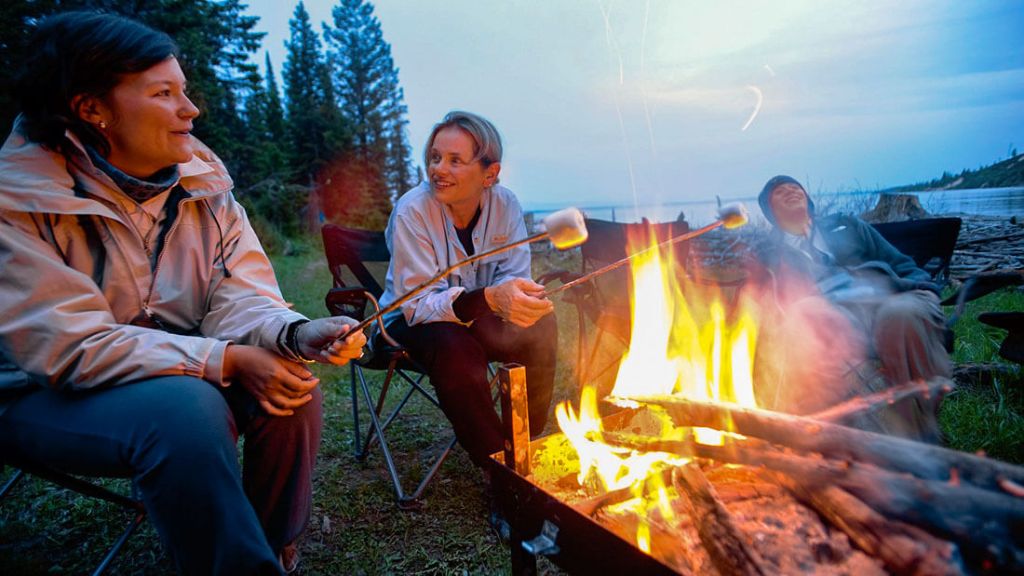
A group of campers roast marshmallows after a full day of paddling on the water.
National Forest Camping: Outside the park, free camping can be found in the nearby national forest. Shadow Mountain Campground is across Highway 191 from the park and boasts spectacular views of the Tetons at sunset. Dispersed camping is also available past the official Curtis Canyon Campground closer to the town of Jackson. Note that neither of these campsites have any amenities or bear boxes and due to treacherous road conditions, a high-clearance vehicle is recommended.
Backcountry Camping: If you prefer a more isolated experience, you can pick up a backcountry camping permit from the Jenny Lake Ranger Station or the Colter Bay and Craig Thomas Discovery visitor centers. One-third of backcountry campsites can be reserved in advance and two-thirds are reserved for walk-ins. Advanced reservations cost $45 per trip and walk-ins cost $35 per trip. Remember, park-approved bear canisters are required for all backcountry campsites. The park provides them at no cost, but they can also rented from several nearby outfitters in the town of Jackson.
Lodges: If sleeping on the ground isn’t your style, there are plenty of options inside the park ranging from modest hostels to upscale full-service lodges. The Grand Teton Climber’s Ranch is located just four miles north of park headquarters and offers an affordable and accessible option for alpinists staging bigger climbs. Signal Mountain Lodge has an array of log cabins with a few waterfront rooms right on the shore of Jackson Lake. The cabins are a comfortable blend of wilderness and rustic elegance, and make a great jumping-off point for a boating or fishing excursion.
Jackson: Only 10 miles south of the Moose park entrance, the town of Jackson offers lodging options for park visitors. The historic town square boasts a classic Old West vibe, complete with elk-antler arches, and plenty of shops and restaurants to keep you busy at night. The town bumps right up against the National Elk Refuge, which manages winter habitat for thousands of elk.
Best Time to Visit
Summer: It’s no surprise that Grand Teton National Park’s busiest season is the summer. With long days and more activities than you could complete in a month, the park is bursting with activity from June through August. Temperatures rise to the high 80s and occasionally the 90s, making it the best time to enjoy a swim in the park’s many lakes.

A herd of bison graze outside of Kelly, Wyoming. (Photo credit: Sam Morse)
Fall: Grand Teton National Park is one of the most picturesque places to be when the leaves start to change. Late September is an ideal time to enjoy the vibrant foliage and clear skies before winter. Lodging and travel also tend to be less expensive in the fall when the summer crowd starts to dwindle, but the weather can be unpredictable. Fall temperatures range from the 60s and sunny to full-on winter storms.
Winter: Midwinter in Grand Teton National Park is not for the faint of heart—the coldest temperature ever recorded in the park was -63°F—but the harsh temps provide a unique opportunity to enjoy the pristine wilderness without many other people. Whether you’re backcountry skiing, cross-country skiing or snowshoeing, winter in the Tetons is a challenging, but rewarding experience.
Spring: While the melting snow and muddy trails make it difficult to hike, mountain bike or ski, springtime is a rare moment to have Grand Teton National Park all to yourself. You won’t be totally alone, though—spring is primetime for wildlife spotting. In early April, thousands of elk begin their migration north for the summer, bears wake from their winter slumber, beavers pop out from melting ponds and bighorn sheep descend from higher elevations.
Getting there
Airport: The Jackson Hole Airport is the only airport in the country that’s inside a national park. If you fly in on a clear day, you’ll enjoy a unique view of the Tetons from above before touching down. If you can’t get a flight into Jackson, Salt Lake City and Idaho Falls offer the next closest airports to Grand Teton National Park, five hours and two hours away, respectively.
Driving From Yellowstone: The northern terminus of Grand Teton National Park is only eight miles south of the South Entrance of Yellowstone (Jackson is just 60 miles south of Yellowstone), making the two national parks a common linkup. The connecting road is open from April through November, conditions dependent.
Parking: In the summer, the daily park entrance fee is $35 per vehicle and $20 per pedestrian or cyclist. If you plan to spend more than a day or two in Grand Teton National Park (or any other national park in the country), consider purchasing an $80 annual pass. An annual pass will give you unlimited access to any national park in the country for 12 months from the purchase date.
